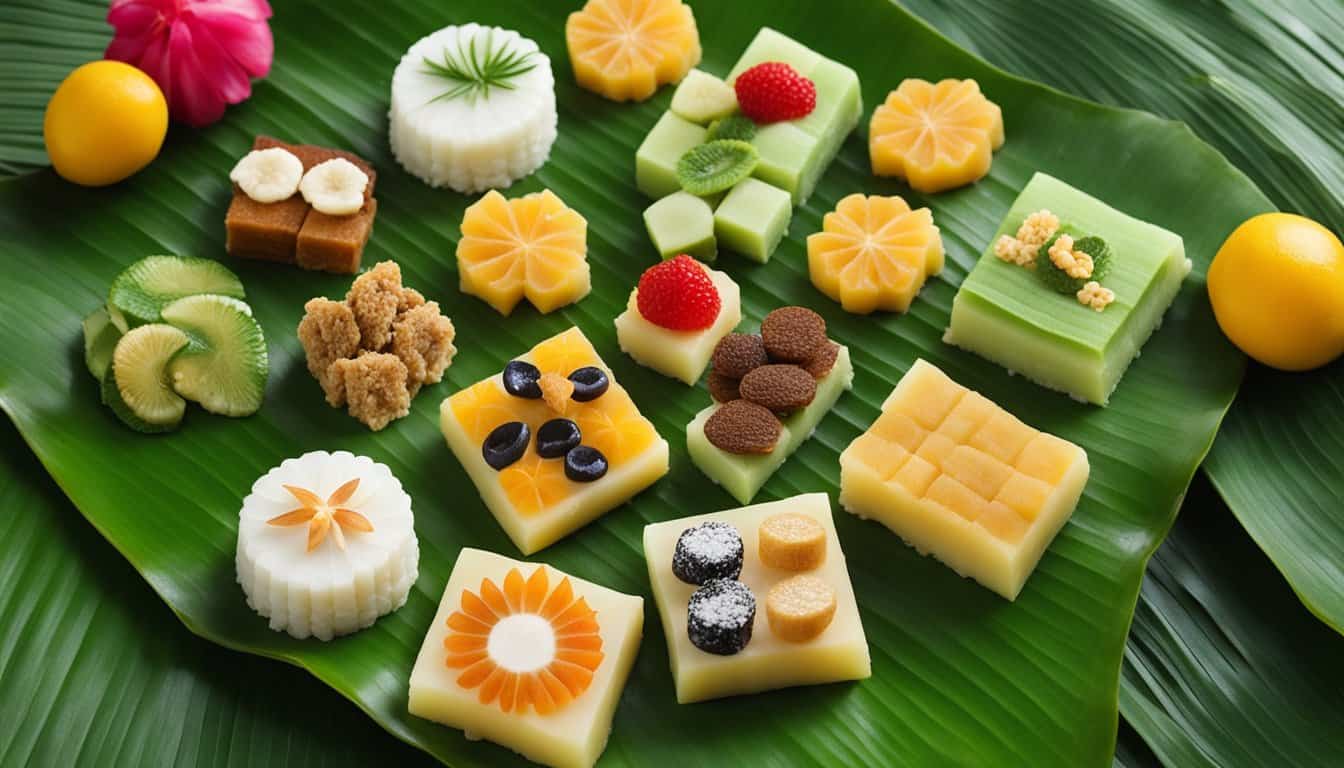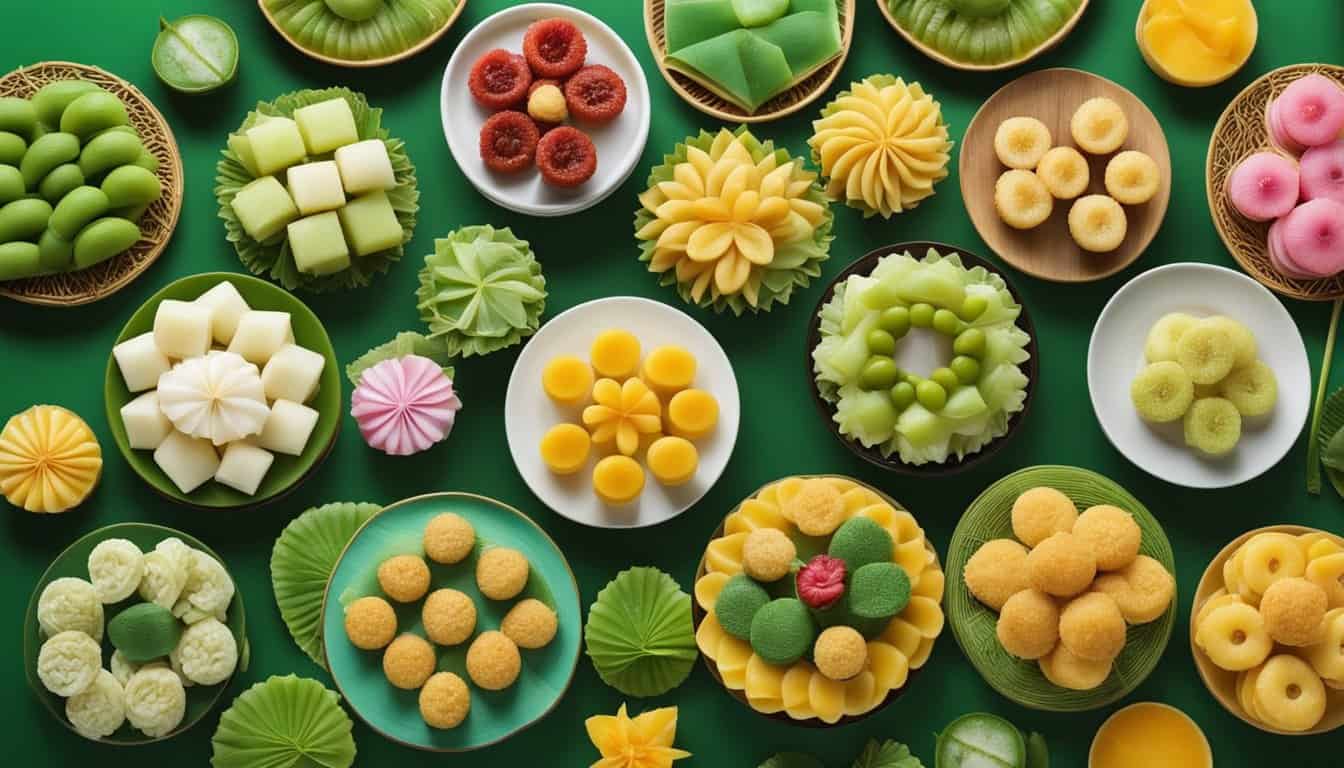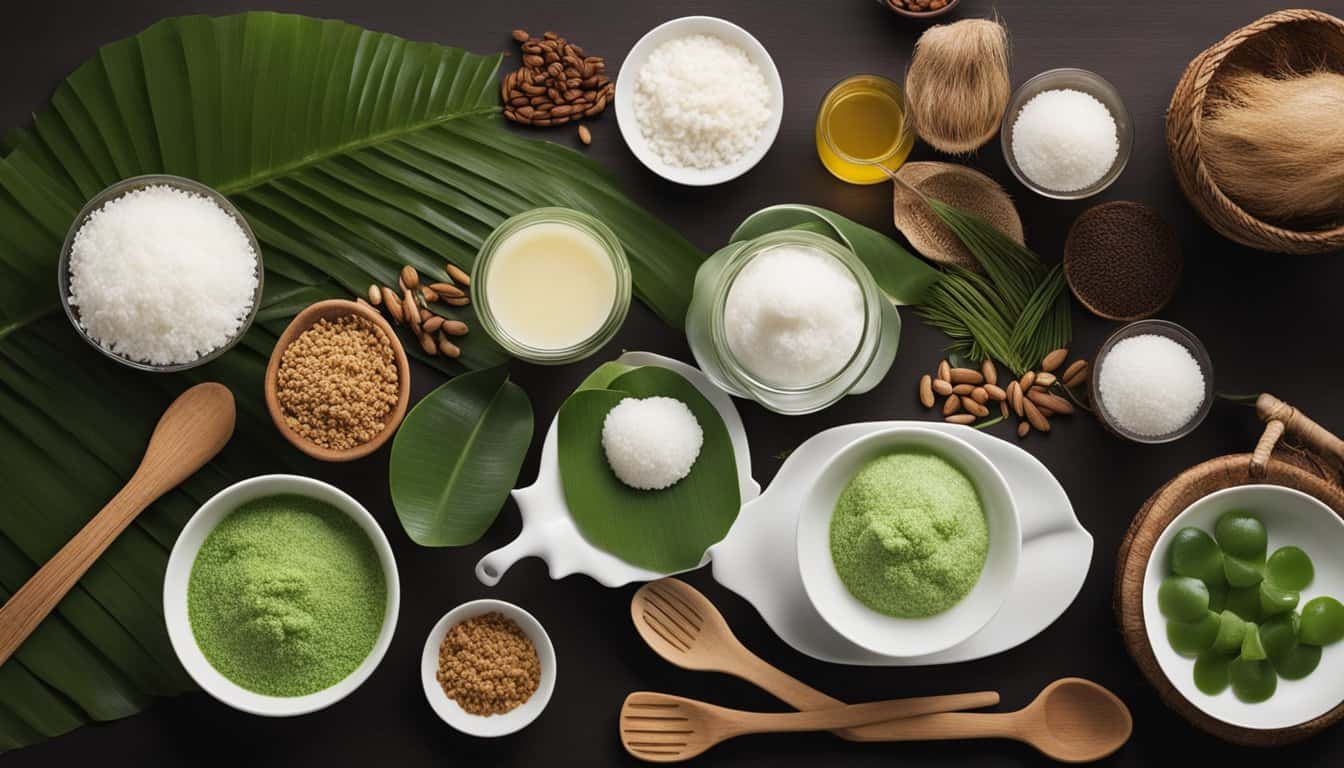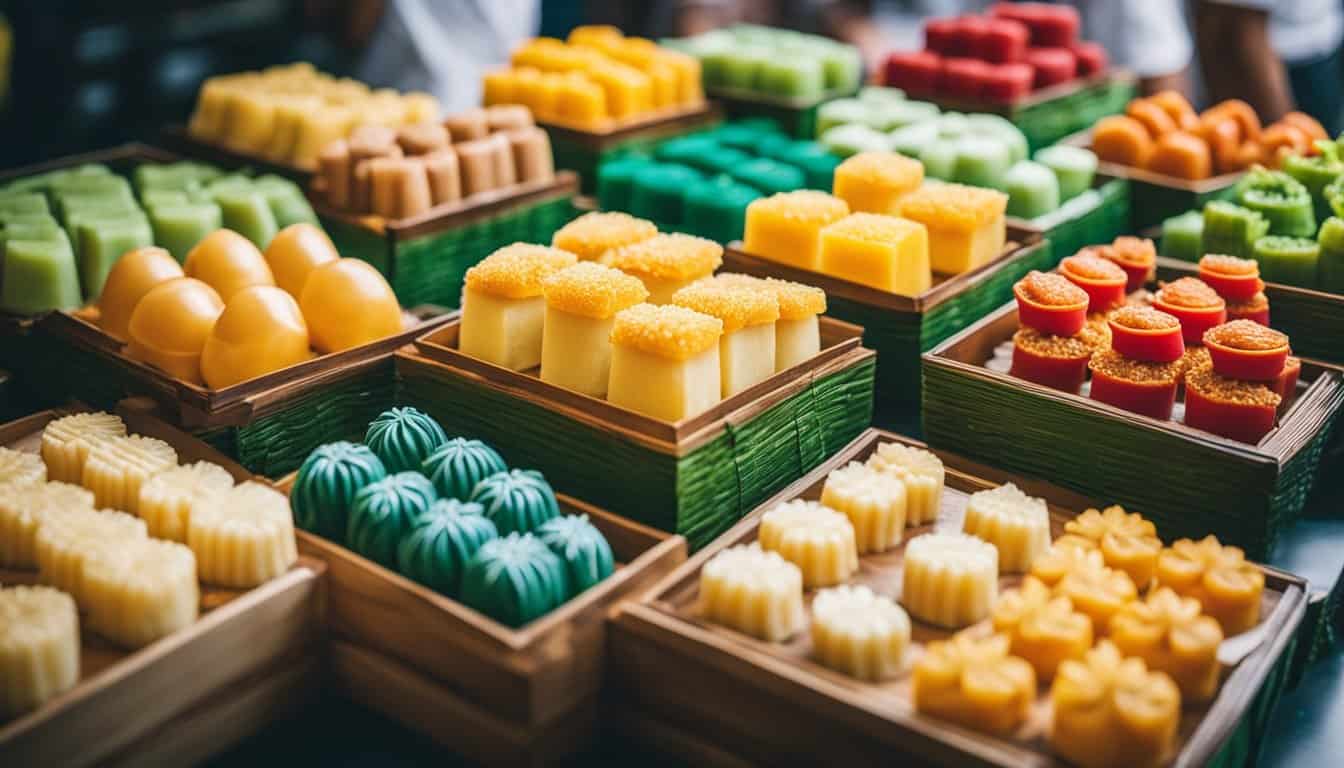If you’re a foodie visiting Singapore, you must try kueh, one of the most iconic and beloved sweet and savory snacks in the country. Kueh is a traditional bite-sized delicacy that’s made with a variety of ingredients such as rice flour, coconut milk, pandan leaves, and palm sugar. It has a soft, chewy texture and comes in a range of colors, shapes, and flavors. Whether you’re looking for a quick snack or a tasty dessert, kueh is the perfect treat to satisfy your cravings.

Kueh has a rich history and culture in Singapore, dating back to the early Peranakan communities. The Peranakans, also known as the “Straits Chinese,” were descendants of Chinese immigrants who settled in the Malay Archipelago in the 15th century. They were known for their unique blend of Chinese and Malay cultures, which is reflected in their food, including kueh. Today, kueh is an essential part of Singapore’s culinary heritage and is enjoyed by locals and tourists alike.
Key Takeaways
- Kueh is a traditional sweet and savory snack in Singapore, made with rice flour, coconut milk, pandan leaves, and palm sugar.
- Kueh has a rich history and culture in Singapore, dating back to the early Peranakan communities.
- Kueh is an essential part of Singapore’s culinary heritage and is enjoyed by locals and tourists alike.
History and Culture of Kueh
If you’re looking for a traditional Singaporean snack, you can’t go wrong with kueh. These bite-sized cakes come in a variety of flavors and textures, and are beloved by locals and visitors alike. But where did kueh come from, and how did it become such an important part of Singaporean culture?
Origins and Evolution
The history of kueh can be traced back to China, where rice cakes were a popular snack food. Over time, these cakes evolved to include a wider range of ingredients and flavors, and spread throughout Southeast Asia. In Singapore, kueh became especially popular during the 19th century, when many Chinese immigrants settled in the city-state.
Influence of Malay and Indonesian Cuisine
While kueh has its roots in Chinese cuisine, it has also been heavily influenced by Malay and Indonesian cooking. Many kueh recipes include ingredients like coconut milk, pandan leaves, and palm sugar, which are commonly used in Malay and Indonesian dishes. This blending of culinary traditions has helped make kueh a uniquely Singaporean food.
Nonya Kueh and Peranakan Heritage
One of the most famous types of kueh in Singapore is Nonya kueh, which is named after the Peranakan community. The Peranakans are descendants of Chinese immigrants who married local Malay women, and their culture is a blend of both Chinese and Malay traditions. Nonya kueh is made using a variety of ingredients, including glutinous rice flour, coconut milk, and pandan leaves, and is often served during special occasions like weddings and festivals.
Overall, kueh is a delicious and important part of Singaporean culture. Whether you’re a local or a visitor, you’re sure to enjoy sampling the many different types of kueh available in the city-state.
Types of Kueh

If you are a fan of sweet treats, Singapore’s kueh is a must-try. Kueh is a type of bite-sized snack that comes in a wide range of flavors, textures, and colors. Here are some of the most popular types of kueh you can find in Singapore.
Sweet Kuehs
Sweet kuehs are the most common type of kueh in Singapore. They are usually made with ingredients such as coconut milk, pandan, gula melaka, and sweet potato. One of the most popular sweet kuehs is Ondeh Ondeh, which is made with glutinous rice flour and filled with molten gula melaka. Another popular sweet kueh is Kueh Salat, which is a two-layered kueh made with pandan-flavored glutinous rice and a layer of coconut custard.
Savoury Kuehs
If you prefer savory snacks, there are also plenty of kuehs to choose from. One of the most popular savory kuehs is Ang Ku Kueh, which is a small, red-colored kueh filled with sweet or savory fillings such as peanut or green bean paste. Another popular savory kueh is Kueh Dadar, which is a thin, crepe-like kueh filled with grated coconut and gula melaka.
Kueh Textures and Flavors
Kueh comes in a variety of textures and flavors. Some kuehs are chewy and sticky, while others are firm and soft. Kueh Tutu, for example, is a soft and fluffy kueh filled with ground peanut or grated coconut. Kueh Kosui, on the other hand, is a chewy kueh made with tapioca flour and coated with grated coconut.
Kueh also comes in a range of flavors, from the classic pandan and coconut to more unusual flavors such as durian. Rainbow Lapis is a popular kueh that features layers of brightly-colored kueh with flavors such as pandan, coconut, and sweet potato.
In summary, Singapore’s kueh is a diverse and delicious snack that comes in a wide range of flavors, textures, and colors. Whether you prefer sweet or savory snacks, there is a kueh for everyone to enjoy.
Iconic Kueh Destinations
If you’re a fan of kueh, Singapore has plenty of options to satisfy your cravings. Here are some of the most famous kueh bakeries and must-visit kueh cafes that you should add to your list.
Famous Kueh Bakeries
HarriAnn’s Nonya Table is a popular bakery that has been around for over 20 years. They are known for their delicious kueh lapis and ondeh ondeh, which are made fresh daily. You can also find other traditional Nonya delights like kueh dadar and kueh salat here.
Tiong Bahru Galicier Pastry is another iconic bakery that has been around since the 1970s. They are famous for their kueh bangkit, which is a traditional coconut cookie, and kueh lapis, which is a layered cake. You can also find other kueh like kueh salat and ondeh ondeh here.
Ji Xiang Confectionery is a family-run bakery that has been around for over 30 years. They are known for their handmade ang ku kueh, which is a traditional Chinese pastry filled with sweet or savory fillings. You can also find other kueh like kueh lapis and ondeh ondeh here.
Must-Visit Kueh Cafes
Chalk Farm is a cozy cafe located in Everton Park that serves up delicious kueh and other sweet treats. They are known for their kueh salat, which is a layered cake made with pandan and coconut milk. You can also find other kueh like kueh dadar and ondeh ondeh here.
Kueh Garden is a cute little cafe located in Bukit Merah that specializes in kueh. They have a wide variety of kueh to choose from, including kueh lapis, kueh dadar, and ondeh ondeh. They also have a selection of coffee and tea to pair with your kueh.
Haig Road Putu Piring is a popular stall located in Geylang that serves up delicious putu piring. Putu piring is a traditional Malay snack made with steamed rice flour and filled with sweet coconut filling. This stall has been around for over 50 years and is a must-visit for any kueh lover.
These are just a few of the many iconic kueh destinations in Singapore. Whether you’re in the mood for traditional Nonya kueh or Chinese ang ku kueh, there is something for everyone. So, go ahead and indulge in some of the best kueh Singapore has to offer!
Kueh Making and Ingredients

If you’re a fan of kueh Singapore, you may be interested in learning about how these delicious treats are made. Traditional preparation techniques and key ingredients play a significant role in creating the unique taste and texture of kueh.
Traditional Preparation Techniques
Kueh can be prepared in a variety of ways, including steaming, boiling, baking, and frying. One traditional technique involves using banana leaves to line the bottom of a steamer before adding the kueh batter. This imparts a subtle flavor to the kueh and also makes it easier to remove from the steamer once it’s cooked.
Another technique involves layering different colored kueh batters to create a visually stunning treat. This is commonly seen in the popular nine-layer kueh (九层糕), which is made by layering different colored batters made from glutinous rice flour, tapioca flour, sugar, and coconut milk.
Key Ingredients in Kueh Making
Kueh can be made with a variety of ingredients, but some of the most common ones include coconut milk, gula melaka (palm sugar), pandan, and grated coconut.
Coconut milk is a key ingredient in many kueh recipes and gives them a rich, creamy flavor. It is often used in combination with other ingredients like glutinous rice flour and tapioca flour to create a chewy texture.
Gula melaka, a type of palm sugar, is commonly used to sweeten kueh. It has a unique flavor that is different from regular sugar and adds a depth of flavor to kueh.
Pandan is a tropical plant that is used to flavor and color kueh. Its leaves are often used to extract juice, which is then used to flavor the kueh batter. Pandan is commonly used in kueh dadar, which is a rolled kueh filled with grated coconut and palm sugar.
Grated coconut is another common ingredient in kueh. It is often used as a filling or topping for kueh, and adds a sweet, nutty flavor.
Other ingredients that can be found in kueh include salted bean, corn, yam, sweet potato, green tea, mung bean, peanut filling, ground peanuts, shredded coconut, and egg. These ingredients can be used in a variety of ways to create different types of kueh, each with its unique flavor and texture.
Modern Twists and Trends

Kueh has been a part of Singapore’s culinary heritage for centuries. While traditional kueh varieties still remain popular, the younger generation has started experimenting with new flavors and combinations. Here are some modern twists and trends that have emerged in the world of kueh:
Fusion Kueh Varieties
Fusion kueh varieties have become increasingly popular in recent years. These kueh varieties combine traditional flavors with modern ingredients to create unique and exciting taste experiences. Some examples of fusion kueh varieties include:
- Chocolate Kueh: Chocolate kueh is a modern twist on the traditional kueh. The rich chocolate flavor complements the soft and chewy texture of the kueh perfectly.
- Green Tea Kueh: Green tea kueh is a popular fusion kueh variety that combines the earthy flavor of green tea with the sweetness of kueh. It’s a must-try for any green tea lover.
- Ice Cream Kueh: Ice cream kueh is a fun and playful twist on the traditional kueh. The soft and chewy texture of the kueh pairs perfectly with the creamy and cold ice cream.
- Mango Kueh Chendol: Mango kueh chendol is a refreshing and fruity twist on the classic kueh chendol. The sweet and juicy mango complements the creamy coconut milk and chewy kueh perfectly.
Kueh in Social Media
Kueh has also become a popular topic on social media platforms such as Instagram. Many kueh makers and enthusiasts have taken to Instagram to showcase their creations and share their love for kueh with the world. Here are some popular kueh varieties that have gained a following on Instagram:
- Durian Ambon: Durian ambon is a popular kueh variety that has gained a cult following on Instagram. The sweet and creamy durian filling is encased in a soft and chewy kueh skin.
- Pink Fairy Kueh: Pink fairy kueh is a beautiful and delicate kueh variety that has become popular on Instagram. The pink color comes from natural ingredients such as beetroot and dragon fruit.
- Kaya Custard Kueh: Kaya custard kueh is a popular kueh variety that has gained a following on Instagram. The creamy and sweet kaya custard filling is encased in a soft and chewy kueh skin.
- Putu Ayu: Putu ayu is a popular kueh variety that has become popular on Instagram. The soft and fluffy kueh is filled with sweet coconut and palm sugar filling.
- Rempah Udang: Rempah udang is a spicy and savory kueh variety that has gained a following on Instagram. The filling is made with shrimp and a blend of spices and herbs.
- Lemper Udang: Lemper udang is a savory kueh variety that has become popular on Instagram. The filling is made with shrimp and rice, and is wrapped in a soft and chewy kueh skin.
In conclusion, the world of kueh is constantly evolving and adapting to new trends and flavors. Whether you prefer traditional kueh varieties or modern fusion kueh, there is something for everyone to enjoy.
Celebrating Kueh
Kueh is an integral part of Singapore’s culinary heritage. These bite-sized treats have been enjoyed by locals and visitors alike for generations. Whether you are looking for a sweet or savory snack, you will find plenty of options to choose from.
Kueh in Singaporean Festivals
Kueh is an essential part of many Singaporean festivals. For example, during the Chinese New Year celebrations, pineapple tarts are a must-have treat. These buttery, melt-in-your-mouth cookies are filled with sweet pineapple jam and are a favorite of many. Another popular kueh during this festive season is the kueh lapis. This colorful layered cake is not only delicious but also visually stunning.
During the Malay festival of Hari Raya, you will find a variety of traditional Malay kuih. These sweet treats come in a range of shapes and flavors. Some of the most popular kuih include ondeh-ondeh, a glutinous rice ball filled with palm sugar and coated in grated coconut, and kueh dadar, a pandan-flavored crepe filled with grated coconut and palm sugar.
Kueh as Everyday Treats
Kueh is not just reserved for special occasions. You can find these tasty treats in coffee shops, cafes, and bakeries all over Singapore. Some of the most popular kueh include the soon kueh, a Hokkien-style dumpling filled with turnip and other ingredients, and the kueh salat, a Nonya-style kueh made with glutinous rice and coconut milk.
If you are looking for a more modern take on kueh, many cafes and bakeries in Singapore offer unique twists on traditional kueh. For example, you might find kueh made with matcha or other unique flavors. These modern kueh are the perfect way to experience the rich culinary traditions of Singapore while also enjoying a contemporary twist.
In conclusion, kueh is an essential part of Singapore’s culinary heritage. Whether you are enjoying kueh during a festival or as an everyday treat, you are sure to be delighted by the range of flavors and textures available. So the next time you are in Singapore, be sure to try some kueh and experience the rich cultural traditions of South-East Asia.
Frequently Asked Questions
What are the must-try types of kueh when visiting Singapore?
When in Singapore, you must try out the traditional kueh that the country has to offer. Some of the must-try types of kueh include Ang Ku Kueh, Kueh Lapis, Ondeh Ondeh, Kueh Salat, and Kueh Dadar. These kueh are available in various flavors and textures and are a treat for your taste buds.
Where can I find the best Nonya kueh in Singapore this year?
If you are looking for the best Nonya kueh in Singapore this year, you should check out the 99 Nonya Kueh. They offer a wide variety of Nonya kueh that are made fresh daily. You can also try out HarriAnns, which is known for its delicious kueh lapis and ondeh ondeh.
Can you share some insights into the history and tradition of Singaporean kueh?
Singaporean kueh has a rich history and tradition that dates back to the early days of Singapore. The kueh was originally made by the Peranakan community, who combined Chinese and Malay ingredients and cooking techniques to create unique flavors and textures. Over time, the kueh evolved to include new flavors and ingredients, and today, it is a beloved dessert in Singapore.
Which are the top spots to buy authentic Malay kueh in Singapore?
If you are looking for authentic Malay kueh in Singapore, you should check out Hajjah Mona Nasi Padang and Chinta Manis. These two spots offer a wide variety of Malay kueh that are made fresh daily and are known for their authentic flavors.
What ingredients typically go into making a delicious Nyonya kueh?
The ingredients that typically go into making a delicious Nyonya kueh include glutinous rice flour, coconut milk, pandan leaves, palm sugar, and other flavorings such as gula melaka. These ingredients are combined to create a unique flavor and texture that is loved by many.
Where can I find halal-certified kueh in Singapore?
If you are looking for halal-certified kueh in Singapore, you should check out Kueh Ho Jiak and All Things Delicious. These two spots offer a wide variety of halal-certified kueh that are made fresh daily and are known for their delicious flavors.




